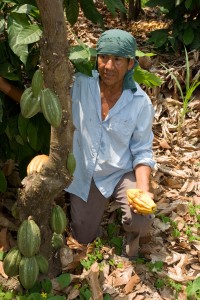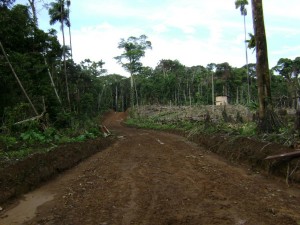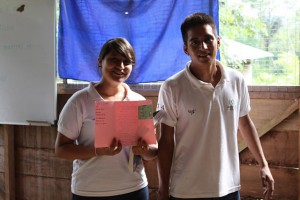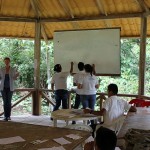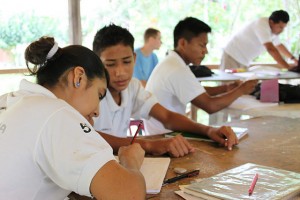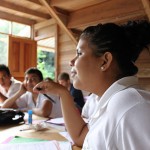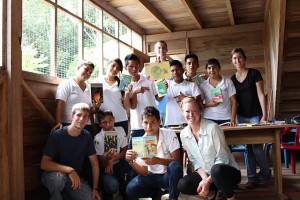Last weekend I went to Tena with the other Yachana volunteers. Even though it’s still in the jungle, Tena is a fairly large city and serves as the gateway between the Andes and Amazon. While it was nice to get some R&R, escape the bugs (though they found me in Tena, too) and take advantage of fast(er) internet, the main purposes of my quick weekend getaway was to bask in the awesomeness that is electric laundry services. In case you missed it earlier, it literally takes DAYS to do laundry in the jungle. And since everything is always damp and border-line musty, I’ve developed an obsession with washing as many clothes as possible whenever I have access to functioning washing machines and dryers.
So literally the second my friend Amanda and I set foot in the “metropolis” of Tena we went off in search of a lavanderia, or “laundry service.” I honestly can put into words how stoked I was to have REALLY clean clothes. We first tried the lavanderia we had used during our previous visit which, according to the larger-than-life sign outside, was just started with the help of a micro-credit cooperative. I must admit I enjoyed the thought of supporting a new venture, especially one that I personally had a need for. As we ascended the steps, I began to notice the absence of whirring spin cycles and dryer buzzers. Worry quickly turned into slight panic. They were closed. Not even a “back in 5” sign was to be found.
But how!? Why!? Their monstrous sign clearly states they should be open at this perfectly normal business hour of 3:00 pm. Confused and devastated, we lugged our jungle-y clothes back to our hostel pondering the fact that it was really no surprise to find a business NOT observing its stated hours of operation in Ecuador. Our next attempt was recommended by our hostel owner, who quickly pointed us in the direction of her employee’s aunt’s brand new lavanderia on the other side of the street. “They’re open all day, even on Sunday!” she said. Another new business to support and they’re open? Perfect. Let’s go.
The drop-off was abnormally smooth. A young boy assured us he could take the “jungle-ness” out of clothes and sent us on our way with “That will be $4.00, you can pick it up tomorrow morning” all in less than 5 minutes. In case you didn’t know, that’s equal to the speed of light in Ecuador.
Then disaster struck. Amanda and I arrived as told the following morning each with $4 in hand. There’s really nothing like clean clothes on a Saturday morning in the jungle, so we were in higher than usual spirits. But once we got back to the hostel and began to unpack, that same feeling of worry and panic consumed us immediately. We both noticed bleach spots on a few items, and then further investigation led to Amanda discovering that nearly all of her clothes had been stained… no… tortured with bleach – and not in the cool tie-dye way.
Mind you, clothes are scarce, precious resource in the jungle. As professionals we struggle to look half way decent while protecting ourselves from bugs, the sun, the heat, razor-sharp plants, and basically everything else the jungle throws our way. And now Amanda’s wardrobe / arsenal of jungle protection had been destroyed by the bleach monster AKA our hostel owner’s employee’s aunt’s son.
“It’s okay,” we told her. “Go back with the hostel owner, explain the situation, get your $4 back and surely they’ll throw in extra to help you buy new clothes.” That’s good customer service, right? Any well-run establishment would surely own up to what was most likely an honest mistake and find a way to make it all better.The response Amanda got was a mix of the following….
“Oh mi hija, people make mistakes. Sometimes that happens. It’s not that bad. The thing is, I was away and well my son was here and he really doesn’t know any better. We can try to dye your clothes back to their original color (I’m going to have to see this to believe it…). I can’t possibly refund your money. There’s nothing I can do for you.” For those familiar with the phrase, she basically told Amanda ‘Sorry I’m not sorry.’
Amanda wasn’t taking no for an answer. “Yes, Señora. People do make mistakes and these things do happen. But it is that bad, and whoever did it should be held accountable.” The encounter ended with the lavanderia owners giving Amanda the silent treatment until she left in frustration. Our hostel owner was just as upset as Amanda with their apathy and encouraged her to reclamar or “file a complaint” at the Tena equivalent of the Better Business Bureau first thing on Monday morning.
But even before Monday came, the customer service revolution was already catching on. News of the bleach disaster started to spread around the hostel, and even the hostel owner had begun to tell her entire circle of friends of her guest’s unfortunate tale. You can bet she won’t be sending any future guests that that lavanderia nor will her other hostel-owning friends. For the lavanderia owner, I imagine that returning Amanda’s $4 compared to losing hundreds of potential customers isn’t looking so bad anymore…
On a semi-unrelated note, I later advised a friend to use the original lavanderia Amanda and I had first tried to go to. Their enormous sign says Monday is good to go, surely it would be open. Right? Nope! Closed again. Am I surprised? Not really.
From my current and previous travels in Ecuador, I’ve learned that good customer service, by international standards, is hard to come by. As an American, I didn’t quite realize its economic value until I experienced its absence. But then I thought – The reason I always shop at certain stores, eat at select restaurants, go out of my way for my favorite coffee shops, and so on, is due in small part to cost and quality, but in larger part to their level of customer service. Good customer service costs practically nothing in the long run, and what you get in return is invaluable: loyal patrons and a positive reputation that will bring your more business than all the obnoxiously large signs in Ecuador ever could.
I’m not saying that there are zero businesses in Ecuador that practice good customer service – there are probably many and I’m sure they’re very successful. But in general, and at least in Tena, someone could make killing on a lavanderia or any other business that followed its listed hours of operation and offered a money-back guarantee to its customers.
I’ve mentioned this before, but I truly believe that Ecuador is at a tipping point with respect to economic development… I see and feel it all around me as I travel throughout the country and meet with budding entrepreneurs. Incorporating customer service best practices could not only potentially speed this process along, but also ensure its sustainability. While I can’t change the whole country over the next 2 months, I do have 10 high school juniors who are eager and willing to learn about entrepreneurship and business design. So while planning my next Village Capital-ito program, I’ve decided to add in a lesson on the other half of what makes a successful business – its customers.
This just in: As I was writing this Amanda sent an email update from Tena. While it took some perseverance, the lavanderia owners might be giving her the money back tomorrow. The Customer Service Revolution is working!


